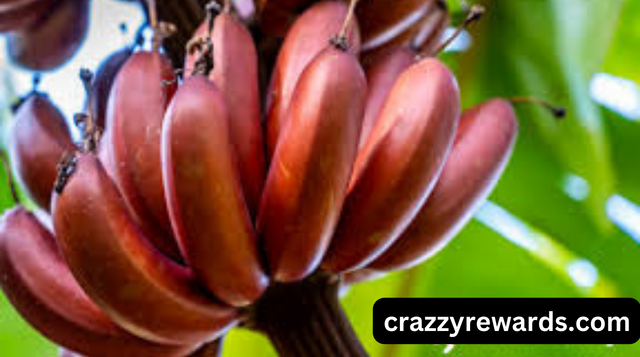Red banana Cultivation:
Friends, welcome to our website crazzyrewards.com. Today I am going to give you complete information about red banana cultivation. The demand for red banana has increased significantly. Farmers have also started cultivating red banana with great attention. Red banana contains all those vitamins and minerals which are not present in normal banana. So, let us know about the method of cultivating red banana and the profits from it.
Tips for cultivating red bananas:
Soil Preparation:
Red bananas prefer well-draining, fertile soil that is rich in organic matter.
Prepare the planting area by digging a hole about 2-3 feet wide and 1-2 feet deep.
Mix in aged compost, manure, or other organic matter to enrich the soil.
Planting:
Obtain suckers or rhizomes from an existing red banana plant.
Plant the suckers or rhizomes about 15-20 feet apart, as red bananas need ample space to grow.
Plant them at the same depth as they were growing previously, with the top exposed.
Water thoroughly after planting.
Care and Maintenance:
Mulch around the base of the plant to retain moisture and suppress weeds.
Water regularly, providing about 1-2 inches of water per week, especially during dry periods.
Fertilize every 2-3 months with a balanced fertilizer or compost to provide nutrients.
Remove any suckers that grow too close to the main plant to avoid overcrowding.
Support:
As the plant grows taller, provide support by staking or tying it to a strong post to prevent toppling over from wind or the weight of the fruit bunch.
Harvesting:
Red bananas take about 9-12 months to produce fruit from planting.
Harvest the entire stem when the top few bananas start turning red, as the rest will ripen over time.
Cut the stem close to the ground, leaving the suckers for future crops.
With proper care, red banana plants can produce fruit for several years in suitable climates. Consistent watering, fertilizing, and protecting from strong winds will ensure a good yield.

Where does red banana come from?
Red bananas were first cultivated mainly in Australia, but over time it reached the Americas, the West Indies and Mexico. However, now farmers have started cultivating it in India also. Red colored bananas are being cultivated extensively in Uttar Pradesh, Tamil Nadu, Maharashtra and Kerala. Farmers are earning huge profits by cultivating it. This banana is in demand not only because of its colour, but also because of the beta-carotene found in it, it is in great demand in the market.
Know the correct method of red banana cultivation and how much benefit you will get from it:-
Cultivation of Red Banana: Calories are found in abundance in red banana. People use it to gain weight and increase strength. It is a matter of pride that farmers in the country are continuously encouraged to do farming as per the demand. Banana is a high-demand cultivar, which is why farmers are cultivating red bananas in large numbers. But there are many varieties of banana which have more demand in the market than normal banana. Which are sold at 2 to 3 times higher rates than normal bananas.
Here are the possible benefits of red banana cultivation?
| Parameter | Value |
|---|---|
| Total Plants per Acre | 200-250 |
| Yield per Plant per Year (bunches) | 1-2 |
| Average Weight per Bunch | 25-35 lbs |
| Total Yield per Acre per Year | 5,000-17,500 lbs |
| Market Price per Pound | $0.50-$1.50 |
| Total Revenue per Acre per Year | $2,500-$26,250 |
| Costs per Acre per Year | |
| Planting Material | $500-$1,000 |
| Labor | $1,500-$3,000 |
| Fertilizers/Pesticides | $500-$1,000 |
| Irrigation | $300-$800 |
| Harvesting/Packing | $500-$1,500 |
| Total Costs per Acre per Year | $3,800-$7,300 |
| Potential Profit per Acre per Year | ($1,300)-$18,950 |
Note: The values provided are approximate and can vary depending on various factors such as climate, soil conditions, farming practices, and market prices in your specific region.
As you can see, red bananas can be a profitable crop if managed correctly. The high end of the profit range ($18,950 per acre per year) represents optimal growing conditions, high yields, and premium market prices. The low end of the range ($1,300 loss per acre per year) represents poor yields, low prices, and higher costs.
To maximize profits, it’s essential to optimize yields through proper agricultural practices, access premium markets that pay higher prices, and keep costs under control through efficient farming methods.

Know how many banana plants should be planted in 1 acre?
Cultivation of Red Banana: Ghulam Mohammad plants around 1300 plants in one acre. Whose distance from plant to plant is 7 feet. The best time for planting banana crop which is ready in 14-15 months is June-July. Banana requires more water, 14-15 days, irrigation has to be done every 16-21 days (according to the soil), but there should not be waterlogging.
The vitamins and minerals found in red bananas, as well as their approximate amounts per 100 gram edible portion, are shown:
| Nutrient | Amount (per 100g) |
|---|---|
| Vitamin C | 15.4 mg |
| Vitamin B6 | 0.292 mg |
| Folate | 14 μg |
| Niacin | 0.554 mg |
| Riboflavin | 0.058 mg |
| Thiamin | 0.031 mg |
| Vitamin A | 64 IU |
| Vitamin E | 0.1 mg |
| Vitamin K | 0.5 μg |
| Calcium | 3 mg |
| Iron | 0.26 mg |
| Magnesium | 27 mg |
| Phosphorus | 22 mg |
| Potassium | 358 mg |
| Sodium | 1 mg |
| Zinc | 0.15 mg |
| Copper | 0.078 mg |
| Manganese | 0.268 mg |
| Selenium | 0.6 μg |
Red bananas are particularly rich in vitamins C, B6, and potassium. They also contain decent amounts of folate, niacin, riboflavin, and various minerals like magnesium, phosphorus, and manganese.
The vibrant red color of these bananas is due to higher levels of antioxidants like carotenoids and anthocyanins, which are beneficial plant compounds.
While the nutrient content may vary slightly based on factors like ripeness and growing conditions, red bananas are generally considered a good source of various vitamins, minerals, and antioxidants that contribute to a healthy diet.

Also Read: 8 benefits of eating raw garlic before sleeping at night.
1. Unique appearance and taste:
Red bananas have a striking reddish-purple peel and flesh, which makes them visually appealing and unique compared to regular yellow bananas. They also have a slightly sweeter, creamier, and more intense flavor than regular bananas, which many consumers find appealing.
2. Perceived health benefits:
Red bananas are believed to have higher levels of antioxidants, such as vitamin C, carotenoids, and anthocyanins, which give them their distinctive color. Antioxidants are associated with various health benefits, including reduced risk of chronic diseases. This perception of being a healthier option drives consumer demand.
3. Exotic and specialty appeal:
Red bananas are less common and considered a specialty or exotic fruit in many parts of the world. This novelty factor and perception of exclusivity can make them more desirable for consumers looking for unique and interesting food experiences.
4. Cultural significance:
In certain regions, particularly in parts of Asia and the Pacific Islands, red bananas hold cultural and traditional significance, which contributes to their popularity and demand in those areas.
5. Use in cuisine:
Red bananas are not only enjoyed as a fresh fruit but are also used in various culinary applications, such as baking, desserts, and traditional dishes, which further increases their demand in certain markets.
6. Limited supply:
Red bananas are not as widely cultivated as regular bananas, which can lead to supply constraints and higher demand in markets where they are available.
7. Marketing and promotion:
Effective marketing and promotion by growers and sellers can highlight the unique qualities and potential health benefits of red bananas, driving consumer interest and demand.
Overall:
The combination of their distinctive appearance, perceived health benefits, exotic appeal, cultural significance, culinary uses, and limited supply contribute to the high demand for red bananas in various markets around the world.

Read More: Red banana Cultivation
